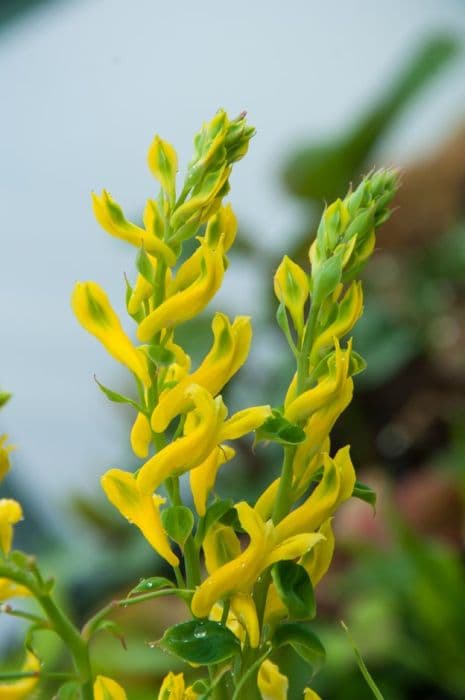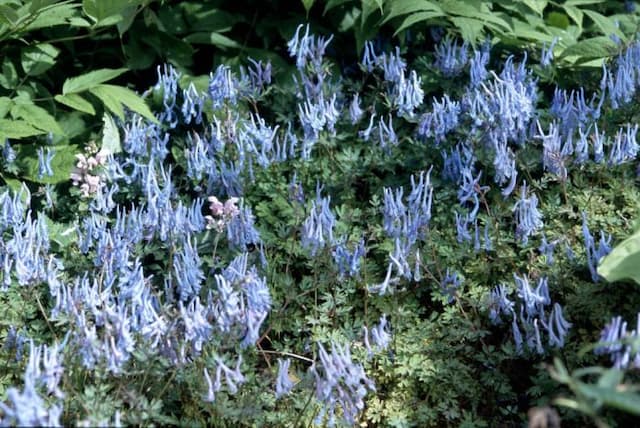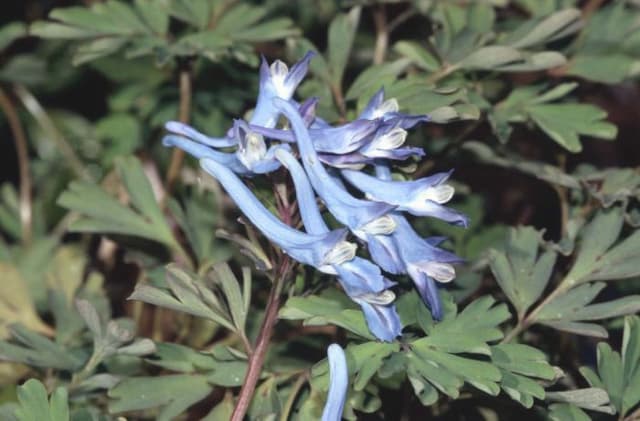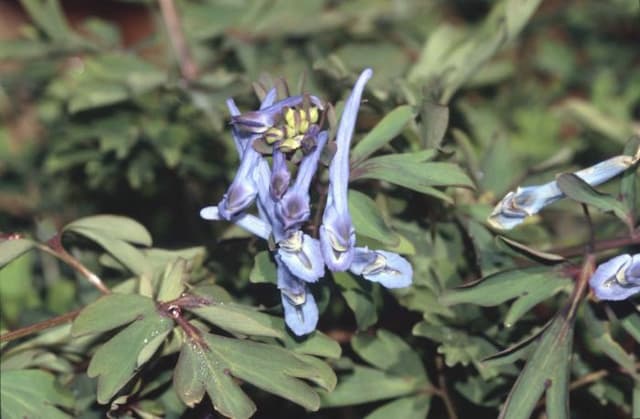Oriental Poppy Papaver (Oriental Group) 'Effendi'
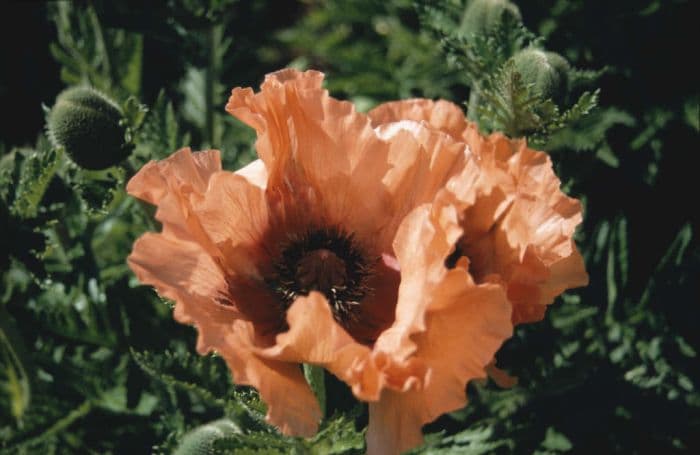
ABOUT
The Oriental poppy 'Effendi' is a perennial plant known for its showy and large blossoms that make it a standout in any garden. The flowers of 'Effendi' are typically a deep, rich red or orange-red hue, and they exhibit a silky, almost luminescent quality that catches the light and the eye. At the center of the flower, there is often a dark, black or purple blotch that provides a striking contrast to the vibrant petals. The petals themselves are delicate and papery, with a slightly crinkled texture that further enhances their beauty. The leaves of 'Effendi' are hairy, deeply lobed, and have a somewhat coarse texture. They emerge near the base of the plant and can paint the garden with a lush green backdrop that accentuates the flowers. The foliage sometimes takes on a bluish-green hue which adds a cool tone to the overall appearance, contrasting nicely with the warmth of the blooms. After blooning, the plant produces a unique seedpod that is oblong and ridged. These seedpods are also an attractive feature of the Oriental poppy 'Effendi', adding structural interest to the garden even after the petals have fallen. The combination of striking flowers, interesting foliage, and architectural seedpods makes this plant a favorite among gardeners who wish to create a bold statement in their outdoor spaces.
About this plant
 Names
NamesFamily
Papaveraceae
Synonyms
Oriental Poppy, Effendi Oriental Poppy
Common names
Papaver orientale 'Effendi'.
 Toxicity
ToxicityTo humans
Oriental poppy has a low level of toxicity to humans. While not typically considered highly poisonous, ingesting parts of this plant can still cause unpleasant symptoms. The severity varies from person to person. If ingested, the plant may irritate the digestive system, causing symptoms such as stomach pain, nausea, vomiting, and diarrhea. Contact with the sap may also cause skin irritation or an allergic reaction in some individuals. It is recommended to avoid ingesting this plant and to handle it with care if prone to skin reactions.
To pets
Oriental poppy is considered to have low toxicity to pets as well. However, if a pet ingests part of this plant, they may experience mild to moderate gastrointestinal upset, which may manifest as drooling, vomiting, or diarrhea. Some pets might also experience a loss of appetite or changes in behavior if they consume a significant amount. It's always best to keep an eye on your pets around plants and contact a veterinarian if you suspect your pet has ingested any potentially harmful plant material.
 Characteristics
CharacteristicsLife cycle
Perennials
Foliage type
Deciduous
Color of leaves
Green
Flower color
Red
Height
2-3 feet (60-90 cm)
Spread
1-2 feet (30-60 cm)
Plant type
Herb
Hardiness zones
3-7
Native area
Central Asia
Benefits
 General Benefits
General Benefits- Attracts Pollinators: The vibrant blooms of Oriental poppy 'Effendi' help attract bees, butterflies, and other beneficial insects to the garden.
- Low Maintenance: Once established, it requires minimal care, making it suitable for gardeners who prefer low-maintenance plants.
- Drought Tolerance: This plant is capable of withstanding periods of dryness once fully established, which can be beneficial in water-restricted areas.
- Seasonal Interest: With its beautiful and large flowers, it provides a striking visual interest during its blooming season in late spring or early summer.
- Deer Resistant: The Oriental poppy 'Effendi' has a degree of resistance to deer, which can help preserve the garden’s aesthetics in areas with a prevalent deer population.
- Garden Design: The plant’s colorful flowers can be used to create stunning contrasts and focal points in garden beds and borders.
- Perennial Growth: As a perennial, it will return each year, adding long-term value and consistency to a garden’s design.
 Medical Properties
Medical PropertiesThis plant is not used for medical purposes.
 Air-purifying Qualities
Air-purifying QualitiesThis plant is not specifically known for air purifying qualities.
 Other Uses
Other Uses- Poppies can be used as a natural dye, where petals of the poppy flowers are boiled to extract colors for fabrics or inks.
- The seed pods of poppies can be dried and used in flower arrangements or as decorative elements in home decor for their distinctive shape and texture.
- Culinary artists sometimes use poppy petals as an edible garnish to add color and a slight flavor to salads and desserts.
- Poppies can be used in photography and fine art for their vibrant colors and dramatic shapes, often symbolizing peace and remembrance.
- The dried stalks of poppies, when harvested and treated, can be used as lightweight stakes for supporting other plants in the garden.
- Poppies can be involved in crafting activities, such as making paper from the fibrous parts of the plant or creating poppy-themed artwork.
- In educational settings, poppies are grown and studied to understand the life cycle of flowering plants and pollinator attractions.
- Poppy petals are sometimes used in potpourri mixtures for their color and subtle fragrance, adding natural beauty to a room.
- The poppy's image is used in fashion design, where its form and colors inspire prints and patterns for textiles and apparel.
- Seed heads of poppies may be used as natural rattles for music making or as part of percussive instruments in crafts.
Interesting Facts
 Feng Shui
Feng ShuiOriental poppy is not used in Feng Shui practice.
 Zodiac Sign Compitability
Zodiac Sign CompitabilityOriental poppy is not used in astrology practice.
 Plant Symbolism
Plant Symbolism- Remembrance: Poppies are widely recognized as a symbol of remembrance, especially in relation to soldiers who have died during wartime. This is largely due to the poem "In Flanders Fields" by John McCrae, which describes poppies growing among soldiers' graves in World War I.
- Peace: Poppies have also come to represent peace and the end of conflict, as they were among the first plants to grow on the battlefields of Europe following World War I.
- Sleep and Respite: The poppy's association with sleep comes from the fact that opium, which is derived from some varieties of poppy, has been used as a sleep aid and painkiller for millennia.
- Death: In Greek and Roman myths, poppies were used as offerings to the dead. Their link to eternal sleep and the afterlife gives them a connection to death.
- Beauty and Resilience: Despite their delicate appearance, poppies are hardy flowers capable of thriving in difficult conditions, symbolizing both beauty and the ability to overcome adversity.
 Water
WaterOriental Poppies, including the 'Effendi' variety, require moderate to low watering once established; they are drought tolerant to some degree. It is best to water them deeply and infrequently to encourage deep root growth. During the growing season, watering once a week with approximately 1 to 1.5 gallons per plant should suffice, depending on the soil and climate conditions. Reduce the amount of water as the plant goes dormant after flowering, and during winter, watering may only be necessary during extended dry spells.
 Light
LightOriental Poppies thrive in full sunlight, where they can receive at least 6 hours of direct sunlight daily. Plant 'Effendi' in a location that is exposed to morning sunlight and protected from the intense heat of late afternoon sun in hotter climates. Adequate light is essential for the plant to produce its showy blooms and maintain healthy growth.
 Temperature
TemperatureThe 'Effendi' Oriental Poppy is cold-hardy and can tolerate winter temperatures down to about -30°F while it is dormant. During the growing season, it prefers temperatures ranging between 50°F and 75°F. Extreme heat above 90°F may stress the plants and cause them to go dormant early.
 Pruning
PruningPruning Oriental Poppies, such as 'Effendi', is mainly focused on deadheading spent flowers to encourage a tidy appearance and sometimes promote a second bloom. After flowering, cut the flower stems down to the base. In late autumn, once the foliage has died back, remove the old foliage to keep the area clean and help prevent diseases. Pruning is usually not needed again until the next flowering cycle.
 Cleaning
CleaningAs needed
 Soil
SoilOriental Poppy 'Effendi' prefers well-draining soil rich in organic matter; a blend of loamy soil, compost, and coarse sand is ideal. The soil pH should be slightly acidic to neutral, ranging from 6.5 to 7.0.
 Repotting
RepottingOriental Poppies, including 'Effendi', are not typically repotted as they are perennial plants growing from a taproot; they do not like their roots disturbed and should be repotted only when necessary, typically every few years if grown in containers.
 Humidity & Misting
Humidity & MistingOriental Poppy 'Effendi' is tolerant of a wide range of humidity levels and does not require high humidity; average atmospheric humidity is generally sufficient for this plant.
 Suitable locations
Suitable locationsIndoor
Provide full sun, well-draining soil, and avoid overwatering.
Outdoor
Plant in full sun, well-drained soil, and space 15-18 inches apart.
Hardiness zone
3-7 USDA
 Life cycle
Life cycleThe life of the Oriental Poppy 'Effendi' starts with seed germination, where under appropriate conditions of warmth and moisture, the seeds sprout and develop into small seedlings. As they grow, these seedlings establish a rosette of leaves at the soil surface while the root system develops underground. The plant enters a vegetative growth stage, during which the leaves expand and the plant puts on substantial growth in preparation for flowering. After the vegetative stage, the Oriental Poppy 'Effendi' produces striking flowers, usually in late spring or early summer, which are pollinated by insects, leading to the formation of seed pods. Once pollinated, the petals fall, and the plant focuses energy on developing the seed pods, which mature and eventually release the seeds. Following seed dispersal, the plant often goes dormant, with the foliage dying back in the summer heat, only to regenerate from its perennial rootstock when conditions become favorable again.
 Propogation
PropogationPropogation time
Spring-Early Summer
The Oriental Poppy 'Effendi' is typically propagated by division, a method where the plant's root clumps are split into smaller pieces. The best time to propagate Oriental Poppies by division is in late summer, after the plant has flowered and begun to die back, or in early fall. To propagate through division, carefully dig up the plant, making sure to get as much of the root system as possible. Shake off excess soil and use a sharp knife or spade to divide the clump into smaller sections, each with several growth points or buds. Replant these divisions at the same depth they were originally growing, spacing them about 12 to 18 inches (30 to 45 centimeters) apart to allow for growth. Water the new divisions well and keep the soil moist until the plants are established.
